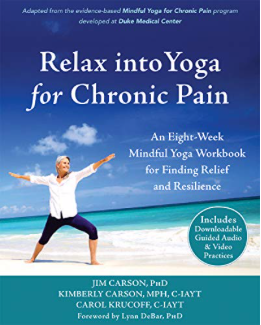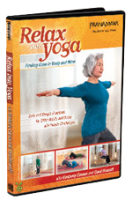By Carol Krucoff, C-IAYT, E-RYT
If you think you’re an expert in breathing just because you’ve been doing it all your life, take this test:
Put one hand on your chest and the other hand on your belly. Close your eyes and take several full, deep breaths, paying close attention to the movement of breath in your body. When you inhale fully and completely, which part of your torso expands the most — your chest or your belly?
If you answered “chest,” like many people you’re breathing inefficiently and missing out on one of the simplest and most powerful techniques for enhancing your health and reducing stress–abdominal breathing.
A proper deep breath (also called diaphragmatic breathing or belly breathing) is your body’s own built-in relaxation mechanism. When you bring air down into the lower portion of the lungs, where oxygen exchange is most efficient, it triggers a cascade of calming physiologic changes: the heart rate slows, blood pressure decreases, muscles relax, anxiety eases and the mind quiets down.
Grandma knew this when she told you to take a deep breath and count to “10” whenever you’re upset. Abdominal breathing is nature’s own “anti-stress” medicine — it’s free, easy and right under your nose.
Over the last two decades, as I’ve presented this “chest or belly” test during public talks, I’ve seen increased awareness of the importance of diaphragmatic breathing. Twenty years ago, the few people who knew about abdominal breathing were typically singers, musicians, martial artists and yoga practitioners. Now, more people understand the value of diaphragmatic breathing, yet there is still significant confusion about proper breathing mechanics. The new challenge of wearing a mask has further complicated this basic function.
In our sedentary, anxious world, many people tend to be shallow “chest breathers,” who primarily use just the middle and upper portion of the lungs. Sometimes this is from misguided efforts to look slim by “sucking in the gut” and puffing out the chest. Often, it’s related to a constant barrage of stress, which causes muscles to tense and respiration rate to increase. This can result in a vicious cycle: We breathe shallowly because we’re under stress, which makes the body feel as if it’s not getting enough air, which–in turn–can prompt quicker, shallower breathing.
Yogis have known for thousands of years–and modern studies confirm–that proper breathing is important for good health and provides a powerful link between body and mind. Breathing is the only physiologic function that you can do either consciously or unconsciously, as it’s controlled by two different sets of nerves and muscles: voluntary and involuntary. You don’t need to think about breathing–your body will breathe automatically. But you can also take control of your breath, which provides a unique doorway into the autonomic nervous system–the control center that revs you up for “fight or flight” when you perceive danger and calms you down to “rest and digest” when the emergency is over.
Yoga tradition also recognizes a connection between the breath and the spirit, with the same Sanskrit word–prana–signifying “breath” and “vital energy” or “life force.” Other ancient languages also have one word that means both breath and spirit: the Latin spiritus, the Hebrew ruach, and the Greek pneuma. English gives a brief nod to this concept in the word “respiration.”
As we navigate this challenging time–facing a virus and social unrest that sometimes “takes our breath away”–here are a few basic breathing lessons:
*Breathe through your nose. Inhaling through the nose has many advantages–including reducing the risk of infection–since the nostrils have little hairs that filter, warm and moisten the air. Exhaling through the nose helps slow and regulate the breath, which is why the yogis say “the nose is for breathing, the mouth is for eating.” In some circumstances–such as for people with lung disease or athletes in high-exertion sports–exhaling through the mouth may be advised. For example, people with COPD who find it difficult to exhale may benefit from the technique of “pursed-lip breathing,” which involves inhaling through the nose and exhaling through pursed lips.
*Learn proper breathing mechanics. To practice diaphragmatic breathing, click this link for instructions in the Relaxed Abdominal Breath.
*Extend your exhalation to relax body and mind. When your exhalation is longer than your inhalation, it’s a signal to your nervous system that you can relax, everything is fine. Just as a natural reaction to finally sitting down after working hard is to let out a long sigh, ahhh. . . .extending your exhalation invites the relaxation response, which counters the physiologic effects of the “fight or flight” stress response.
For guided audio instruction in five basic yoga breathing practices–the relaxed abdominal breath, the three-part breath, even breath, extended exhalation and mantra breathing, visit my YouTube page and click on Breathing Lessons.
Wishing you good health,





